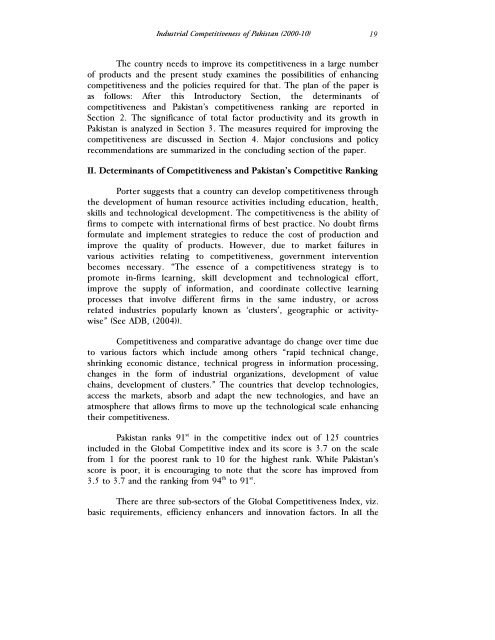Special Edition-07.pdf - Lahore School of Economics
Special Edition-07.pdf - Lahore School of Economics
Special Edition-07.pdf - Lahore School of Economics
You also want an ePaper? Increase the reach of your titles
YUMPU automatically turns print PDFs into web optimized ePapers that Google loves.
Industrial Competitiveness <strong>of</strong> Pakistan (2000-10) 19<br />
The country needs to improve its competitiveness in a large number<br />
<strong>of</strong> products and the present study examines the possibilities <strong>of</strong> enhancing<br />
competitiveness and the policies required for that. The plan <strong>of</strong> the paper is<br />
as follows: After this Introductory Section, the determinants <strong>of</strong><br />
competitiveness and Pakistan’s competitiveness ranking are reported in<br />
Section 2. The significance <strong>of</strong> total factor productivity and its growth in<br />
Pakistan is analyzed in Section 3. The measures required for improving the<br />
competitiveness are discussed in Section 4. Major conclusions and policy<br />
recommendations are summarized in the concluding section <strong>of</strong> the paper.<br />
II. Determinants <strong>of</strong> Competitiveness and Pakistan’s Competitive Ranking<br />
Porter suggests that a country can develop competitiveness through<br />
the development <strong>of</strong> human resource activities including education, health,<br />
skills and technological development. The competitiveness is the ability <strong>of</strong><br />
firms to compete with international firms <strong>of</strong> best practice. No doubt firms<br />
formulate and implement strategies to reduce the cost <strong>of</strong> production and<br />
improve the quality <strong>of</strong> products. However, due to market failures in<br />
various activities relating to competitiveness, government intervention<br />
becomes necessary. “The essence <strong>of</strong> a competitiveness strategy is to<br />
promote in-firms learning, skill development and technological effort,<br />
improve the supply <strong>of</strong> information, and coordinate collective learning<br />
processes that involve different firms in the same industry, or across<br />
related industries popularly known as ‘clusters’, geographic or activitywise”<br />
(See ADB, (2004)).<br />
Competitiveness and comparative advantage do change over time due<br />
to various factors which include among others “rapid technical change,<br />
shrinking economic distance, technical progress in information processing,<br />
changes in the form <strong>of</strong> industrial organizations, development <strong>of</strong> value<br />
chains, development <strong>of</strong> clusters.” The countries that develop technologies,<br />
access the markets, absorb and adapt the new technologies, and have an<br />
atmosphere that allows firms to move up the technological scale enhancing<br />
their competitiveness.<br />
Pakistan ranks 91 st in the competitive index out <strong>of</strong> 125 countries<br />
included in the Global Competitive index and its score is 3.7 on the scale<br />
from 1 for the poorest rank to 10 for the highest rank. While Pakistan’s<br />
score is poor, it is encouraging to note that the score has improved from<br />
3.5 to 3.7 and the ranking from 94 th to 91 st .<br />
There are three sub-sectors <strong>of</strong> the Global Competitiveness Index, viz.<br />
basic requirements, efficiency enhancers and innovation factors. In all the

















